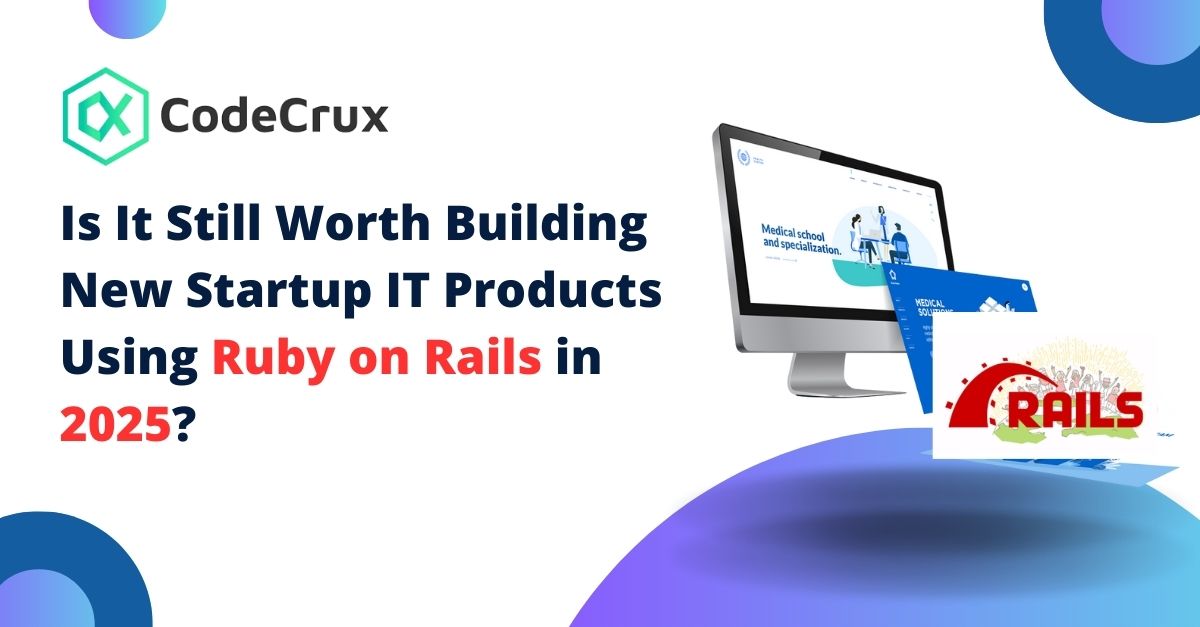Is It Still Worth Building New Startup IT Products Using Ruby on Rails in 2025?

Ruby on Rails (RoR) has been a go-to framework for startups for over a decade, powering some of the biggest names in tech like GitHub, Shopify, and Airbnb. However, as the tech landscape evolves, many developers and entrepreneurs are asking: Is Ruby on Rails still a viable choice for building new IT products in 2025?
In this blog, we’ll explore the current state of Ruby on Rails, its advantages and limitations, and why it remains a strong contender for startups in 2025.
The Current State of Ruby on Rails in 2025
Continued Popularity
Ruby on Rails continues to have a dedicated community of developers and businesses. While it may not dominate tech discussions like it did in its early years, Rails remains a mature, battle-tested framework that’s widely used across industries.
- Active Community: The Rails ecosystem is supported by an active community that regularly updates the framework, ensuring it remains relevant.
- Recent Updates: Rails 7 brought Hotwire, an innovative approach to building modern web applications without heavy JavaScript frameworks, showing that Rails adapts to changing trends.
Industry Adoption
Many startups and SMBs still choose Rails for its simplicity and speed of development. Established companies like Basecamp, Dribbble, and Fiverr continue to rely on Rails, demonstrating its staying power.
Advantages of Using Ruby on Rails for Startups in 2025
1. Rapid Development
Rails is designed with developer productivity in mind. Its convention-over-configuration philosophy allows developers to focus on building features rather than setting up the architecture.
- Built-in Tools: Rails includes everything from ORM (ActiveRecord) to testing frameworks, reducing the need to integrate third-party tools.
- Scaffolding: Generate boilerplate code for models, controllers, and views in minutes, speeding up MVP development.
2. Cost Efficiency
For startups operating on tight budgets, Ruby on Rails offers significant cost advantages:
- Smaller Teams: Thanks to its high productivity, a small team of developers can deliver a robust product quickly.
- Open Source: Rails and its ecosystem of gems (libraries) are open source, reducing licensing costs.
3. Scalable for MVPs and Beyond
Rails is perfect for building MVPs, but it’s also capable of scaling as your startup grows. Companies like Shopify handle millions of users and transactions daily using Rails.
- Horizontal Scaling: Rails works well with modern scaling techniques, including load balancing and containerization with Docker or Kubernetes.
- Cloud Integration: Rails integrates seamlessly with cloud services like AWS, GCP, and Azure.
4. Vibrant Ecosystem
The Rails ecosystem is rich with gems, which are reusable libraries that speed up development.
- Popular gems like Devise (authentication), Pundit (authorization), and Sidekiq (background jobs) provide out-of-the-box solutions for common challenges.
5. Focus on Business Logic
Rails abstracts much of the boilerplate code, allowing developers to focus on solving business problems rather than reinventing the wheel.
Challenges and Considerations
While Ruby on Rails offers many advantages, it’s important to consider the challenges:
1. Performance Limitations
Rails can struggle with performance at extreme scales, especially when handling highly concurrent workloads. However, these limitations are often mitigated by:
- Database optimization techniques
- Adding caching layers (e.g., Redis, Memcached)
- Offloading heavy tasks to background jobs
2. Declining Popularity
While still widely used, Rails is not as trendy as frameworks like Next.js, Laravel, or Django. This could make hiring Rails developers slightly more challenging in certain regions.
3. Front-End Integration
For startups building modern SPAs (Single Page Applications) or PWAs (Progressive Web Apps), Rails alone might not be sufficient. However, Rails’ integration with modern front-end frameworks like React, Vue.js, or Angular solves this issue.
Pro Tips for Startups Choosing Ruby on Rails in 2025
- Start with a Clear Architecture: Leverage Rails’ MVC (Model-View-Controller) architecture but avoid monolithic designs if you plan to scale significantly.
- Adopt Hotwire for Modern UIs: Use Hotwire (introduced in Rails 7) for interactive, dynamic user interfaces without the overhead of front-end frameworks.
- Focus on Testing: Invest in a robust test suite to ensure stability as your app evolves.
- Containerize Early: Use Docker to streamline deployment and scaling.
- Leverage the Community: Tap into the wealth of resources, tutorials, and gems created by the Rails community.
When to Choose Ruby on Rails for Your Startup
Rails is an excellent choice if:
- You need to build and launch an MVP quickly.
- Your app focuses on CRUD operations, such as e-commerce, SaaS platforms, or content management systems.
- You have a small team or limited budget.
- You value simplicity and developer productivity over trendy technologies.
Conclusion
In 2025, Ruby on Rails remains a powerful and relevant choice for startups. Its ability to enable rapid development, reduce costs, and scale with your business makes it an attractive option for many use cases. While it may not dominate headlines, Rails’ maturity, vibrant ecosystem, and focus on developer productivity ensure it’s far from obsolete.
If you’re a startup looking to build a robust product quickly and cost-effectively, Ruby on Rails is still worth considering. With the right development team and strategy, you can leverage Rails to bring your vision to life and scale your business effectively.
Ready to take the next step? Contact experienced Rails developers or agencies to discuss how Rails can power your startup’s success in 2025.